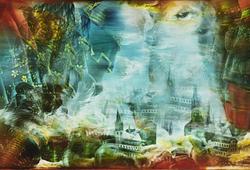A large blue and white bowl, Ming dynasty (1368-1644).
Massive size, rounded sides that rises from a straight foot, decorated in underglaze blue with a riverscape with a large ship sailing down the river. The interior decorated with a central medallion with a building with two scholars and two young boys at play. Around the rim a continuous decoration with alternating squirrels in grape vine and birds on a blossoming cherry branch. Diameter 34.5 cm. Height 16 cm.
Repair. Chips.
Provenance
From the collection of Mr Liljenberg Hansson, a long time member of the British Oriental Ceramics Society who started to collect Chinese Works of Art in the 1970's.
Literature
Regina Krahl, Chinese Ceramics in the Topkapi Saray Museum, Istanbul, Vol II, Yuan and Ming, compare a large bowl with a ship depicted on page 451, TKS15/1541. Described as 'a large ship passing the sea pavillion for viewing the autumn'. Ming, 16th century. Compare also page 676, similar interior decoration on that same bowl.
More information
The inside with decorated with two men under a high gateway flanked with lions, erected to celebrate the most successful candidate of the highest imperial examination, and inscribed Sheng Zhi.













































